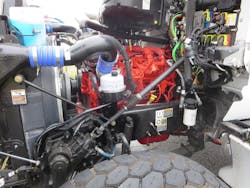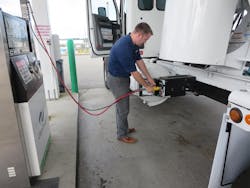Cummins Westport Near Zero Engine Runs Extra Clean
Interest in natural gas as a motor fuel has waned since diesel fuel plunged in price several years ago. That took away NG’s principal advantage of substantially lower cost, which for a while was half that of diesel. That lessened a user’s ability to pay off the high premium to equip a truck to burn it, not to mention the millions of dollars needed to set up an on-site filling station.
So why would Cummins Westport bring out a Near Zero-emissions version of its ISL-G gas-fueled engine and Kenworth make it available? Because ever-cleaner air is still important in California, the state that first mandated low-emissions trucks and cars, says Kurt Swihart, Kenworth’s marketing director. The state has been putting its money where its teeth are with incentive programs to help offset much of the cost of adopting clean-burning engines.
“Near Zero” for the ISL-G—called L9N for model-year 2018—means 0.02 gram per horsepower-hour of nitrogen oxide emissions, or 90 percent less than the federal limit for NOx. A larger ISX12N achieves the same low level for NOx, and a smaller B6.7N emits only 0.1 gram per horsepower-hour, according to Cummins Westport. A natural gas engine emits virtually no particulates and miniscule amounts of other pollutants. Officials at the California Air Resources Board love those small numbers because they mean less smog will occur in regions where it’s been an ongoing problem.
The truck pictured above was built for CalPortland, a concrete producer headquartered in Glendora, near Los Angeles, with operations in California and three other western states. The company is using natural gas to meet clean-air goals, and it’s taking advantage of incentives under California’s Carl Moyer Program and Voucher Incentive Project. State money largely offsets the extra cost of a gas engine, fuel system, and on-board tanks to store compressed natural gas. The state legislature appropriated $12.1 million for 2017 to pay for vouchers for extra-clean heavy trucks (the programs also help pay for Clean Diesel engines, hybrids, and electric vehicles.)
The company is acquiring two CNG fueling stations and plans to add more in the future, Larson said. It’s replacing Catalina Pacific’s current diesel trucks now operating in the Los Angeles area with 118 trucks outfitted as shown here, including two compressed natural gas tanks vertically mounted ahead of the McNeilus drum. Tanks were Type 4, a composite design using aluminum cylinders with polymer liners and wrapped outside in carbon fiber. They won’t corrode and are the lightest CNG tanks available, but also the most expensive (though prices for these are coming down). Together the tanks on this T880S stored 76 diesel-gallon-equivalents (DGEs) when under maximum pressure of 8,600 psi.
Kyle Kimball, Kenworth’s vocational segment manager, was my guide on a demonstration run that started at the builder’s home office in Kirkland, Wash., and consumed much of a day in the Seattle-Tacoma area. He had checked the gauges and found that the tanks would soon need replenishing, but we had enough gas for a couple of hours of cruising over freeways, city streets, and country roads. This included tight turns, which were easily negotiated, and backing, during which the rear booster axle automatically lifted because its caster steering doesn’t work in reverse.
Pressure drops as gas leaves the tanks to be burned in the engine, and was down below 3,000 psi. So we drove to a Clean Energy fueling station near SeaTac airport, and here I saw one of CNG’s downsides: It took a half-hour to pump in 39.44 gallons. Pumping 40 gallons of diesel into a saddle tank takes about 5 or 6 minutes. If a fleet has its own filling station, it can attach hoses and refuel during off-hours, and many do this, so time is less a problem.
Those relying on public CNG stations find that they’re scarce: I saw several trash trucks come and go during our time at the pump, which is fine if you run near one of those stations, but if not, trucks must travel a while to reach them. Drivers I’ve talked with about gas engines always bring this up, and they don’t like it.
Back when the per-gallon price difference was $2 and more, natural gas made a lot of sense and hundreds of fleets started using it. With their up-front infrastructure investments paid off or nearly so, staying in the gas game continues to be advantageous. This is the market now served by Kenworth and other truck builders who offer Cummins Westport natural gas engines, whose sales are made possible by programs like California’s.
An 8.9-liter engine isn’t going to set performance records for a truck as heavy as this T880S mixer that, with a full load and the booster axle down, would legally scale at 66,000 pounds in California. Kimball said a load of wet gravel in the drum put us close to that. This ISL-G was rated at 320 horsepower and 1,000 lb.-ft.—impressive if you go back 40 years when mixer trucks made do with 150 horses and low torque to match—but marginal by today’s standards. It would not be a good engine for the hilly SeaTac region, but is adequate for mostly flat Southern California, where it will be working. And its low dry weight of 1,625 pounds allows healthy payloads. The gas tanks are heavy, but there’s no diesel particulate filter and only an oxidation catalyst in the exhaust system.
An Allison 6-speed automatic transmission compensated for limited power by continuously sending it to the rear wheels. So there was no loss of momentum during shifts, and all I had to do was sometimes mash the accelerator. That was necessary while climbing grades on Interstates 5 and 90, when speed dropped to 25 to 35 mph and the engine buzzed along at 1,700 rpm and more. We were on I-5 during the morning rush hours, so prevailing road speed wasn’t high anyway and we didn’t impede traffic much. On I-90, I set the emergency flashers and stayed in the outside lane while walking up the long grades.
Spark-ignited gas engines tend to be quieter than compression-ignition diesels, and the ISL-G made little noise. Helping, too, was the T880S’s well-insulated cab. Though this was a “marketing” truck, it had a base interior like many customers would order, Kimball said, but it was nice enough that I thought it was a higher level. Ride was good, steering rather precise, stopping safe and steady, and maneuverability more than decent for a set-forward steer-axle truck. It was a good place to work, and I never saw or smelled a bit of exhaust. That’s the point of natural gas.


